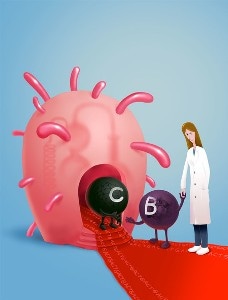Nov 30 2017
Caltech's Frances Arnold, the Linus Pauling Professor of Chemical Engineering, Bioengineering and Biochemistry, and her team, in feat of bioengineering, have formed bacteria that can, for the first time, make chemical compounds having bonds between carbon and boron. Before now, such boron-carbon bonds were formed only in the laboratories of chemists and could not be created by any known life form.
 Artist’s interpretation of a scientist introducing boron to the carbon-based chemistry of life. Jennifer Kan, Xiongyi Huang and their team from the Caltech laboratory of Frances Arnold have created bacteria that can make compounds with boron-carbon bonds for the first time. (Credit: David Chen and Yan Liang (BeautyOfScience.com) for Caltech)
Artist’s interpretation of a scientist introducing boron to the carbon-based chemistry of life. Jennifer Kan, Xiongyi Huang and their team from the Caltech laboratory of Frances Arnold have created bacteria that can make compounds with boron-carbon bonds for the first time. (Credit: David Chen and Yan Liang (BeautyOfScience.com) for Caltech)
The finding forms part of a current wave in synthetic biology, in which living organisms are engineered to make chemical compounds required for agricultural chemicals, pharmaceuticals, and other industrial products. Last year, Arnold's team also formed bacteria to create molecules with silicon-carbon bonds, known as organosilicon compounds, which can be found in everything from semiconductors to pharmaceuticals.
By using biology, researchers can probably make the chemical compounds in "greener" ways that are more cost-effective and generate less toxic waste, according to Arnold.
The results have been published in the November 29 online edition of the Nature journal. The report’s lead authors are Jennifer Kan and Xiongyi Huang, postdoctoral scholars in Arnold's laboratory.
"We have given life a whole new building block that it did not have before," says Arnold, who is also the director of the Donna and Benjamin M. Rosen Bioengineering Center. "This is just the beginning. We've opened a new space for biology to explore, a space that includes useful products invented by humans."
"Nature has created beautiful machinery that we can benefit from," says Huang. "We're repurposing nature's best inventions."
To cajole the bacteria into making boron-containing compounds, the researchers used a technique pioneered by Arnold in the early 1990s termed as directed evolution, in which enzymes are evolved in a lab to perform preferred functions—such as developing chemical bonds that are not found in the biological realm. As was done in the earlier silicon-based research, the researchers began with a common protein known as cytochrome c—but with a variant naturally found in bacteria living in Icelandic hot springs. They mutated the DNA that encodes the protein and then placed the mutated DNA sequences into thousands of bacterial cells to check if the resulting bacteria could form the anticipated boron-carbon bonds. The DNA of successful mutant proteins was then mutated again, and the cycle was done again until the bacteria making the proteins were extremely proficient at forming the boron-carbon compounds.
The researchers created six versions of these proteins, each with marginally different penchants for making a variety of molecules with boron-carbon bonds. Their final bacterial creations were up to 400 times more fruitful than synthetic chemical processes employed for the same reaction.
Kan says that researchers can apply this method to easily produce even more proteins with particular functions.
"The protein DNA is like software that researchers can go in and rewrite," says Kan. "In traditional chemistry, you have to resynthesize a whole chemical catalyst if you want it do something new. But we can do this by simply altering the DNA that tells the bacteria what to make."
Boron, which comes from the mineral borax, is positioned just to the left of carbon on the periodic table. It is a common element found in fertilizers and in composite materials. It is also a vital nutrient of plants, and latest research from NASA's Curiosity rover revealed that it is present on Mars, a sign of likely habitable conditions.
Says Kan, "Boron is one of chemistry's unsung heroes. It is not an element we hear about every day, but its contribution to chemistry is tremendous. We are excited to add this element to the synthetic biology toolbox for the first time."
The Nature study, titled, "Genetically programmed chiral organoborane synthesis," was funded by the National Science Foundation's Office of Chemical, Bioengineering, Environmental and Transport Systems' Sustainable Chemistry, Engineering, and Materials (SusChEM) initiative; and the Jacobs Institute for Molecular Engineering for Medicine. Other Caltech authors are visiting researcher Yosephine Gumulya and graduate student Kai Chen.